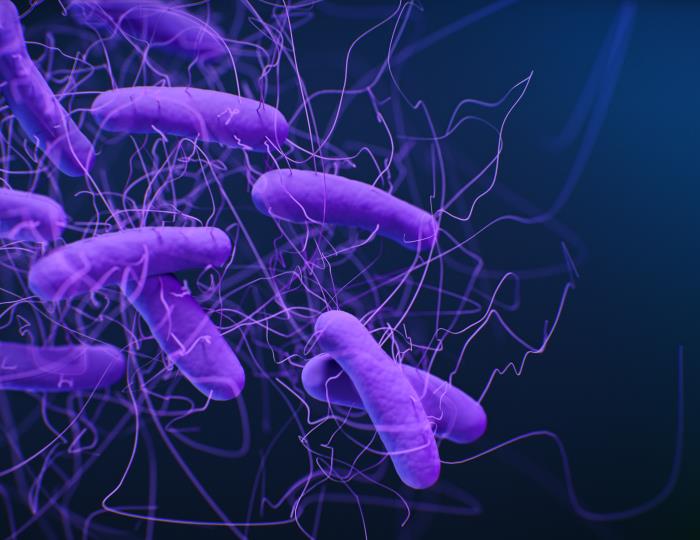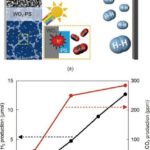Researchers at Pennsylvania State University have developed a synthetic microbiome therapy that, when tested in a mouse model, protects against severe symptoms of the Clostridioides difficile infection (CDI), a difficult-to-treat, potentially life threatening bacterial infection in humans.
The synthetic microbiome therapy draws on the concept of human fecal transplants, a medical procedure where bacteria from a healthy donor’s stool are transferred to a patient’s gastrointestinal tract to restore balance to the microbiome, but doesn’t require any fecal matter. Instead, the researchers applied a computationally guided approach to rationally design synthetic consortia that use fewer but more precise bacteria strains linked to C. difficile suppression. Their approach also identified key bacterial strains as key contributors to C. difficile infection resistance. In preclinical tests, the synthetic fecal microbiota transplant (sFMT1) therapy was found to be as effective as human fecal transplants in mice against C. difficile infection, and with fewer safety concerns.
The team said their findings could lead to the development of new probiotic strategies for humans to treat C. difficile infections as an alternative to antibiotics and conventional fecal microbiota transplants. Their approach, they suggested, is also more generalizable and could be used to study the functions of complex microbial communities across other host-microbiome interactions.
“We need to be much more targeted in our microbiome interventions,” said Jordan Bisanz, PhD, assistant professor of biochemistry and molecular biology, and the Dorothy Foehr Huck and J. Lloyd Huck Early Career Chair in Host-Microbiome Interactions. “This project is a first step in trying to understand how complex microbial communities function to affect the host, then turning that around to learn how to develop microbiome-targeted therapies.”
Bisanz is senior author of the researchers’ published paper in Cell Host & Microbe, titled, “A designed synthetic microbiota provides insight to community function in Clostridioides difficile resistance,” in which the team stated, “In this manuscript, we report a computationally guided approach to rationally design synthetic consortia without relying on prior mechanistic knowledge.” The researchers also filed a provisional application to patent the technology described in the paper.
While many people carry C. difficile in their gut, it usually doesn’t cause a problem, because typically, the organisms in the microbiome keep each other in check. However, C. difficile can overgrow when the balance of the gut microbiome is disrupted, causing severe diarrhea, abdominal pain, and colon inflammation. Antibiotics can tip the scales, creating an environment where C. difficile can flourish by knocking out good bacteria along with harmful ones. “C. difficile is normally suppressed by antagonistic relationships with members of the healthy gut microbiota, which are depleted during antibiotic treatment,” the authors explained. Infection can often set in after a visit to the hospital or other healthcare setting. “Clostridioides difficile infection (CDI) is among the most common nosocomial infections resulting in 500,000 annual infections and associated healthcare costs in excess of 1.5 billion dollars in the USA alone,” the team continued.
Treating these infections is challenging. Antibiotics aren’t effective against C. difficile because the bacteria are drug-resistant. “C. difficile’s capacity to form disinfection-resistant spores further complicates treatment, as the environment may be a significant source of exposure,” the scientists noted. Antibiotics also further disrupt the gut microbiome, creating a positive feedback loop that leads to recurrent infections.
One therapy that has proven effective, Bisanz said, is a fecal microbiota transplant (FMT), which is designed to restore a healthy balance of bacteria in the gut. However, it’s not without risks. “To a certain extent, a fecal transplant is almost like going to the pharmacist where they take a little bit of everything off the shelf and put it into one pill, assuming that something will probably help,” Bisanz pointed out. “But we don’t know 100% what’s in there.” Sometimes, Bisanz said, fecal transplants may unknowingly contain disease-causing bacteria. The authors further commented, “FMT represents perhaps one of the most extreme and effective microbiota-targeted therapies; however, FMT’s greatest strength is also its greatest weakness: complexity … Despite being highly efficacious, FMT comes with safety concerns including the accidental transmission of multidrug-resistant pathogens, transmission of unexpected metabolic phenotypes, and a lack of a stable composition/formulation.”
The researchers wondered, instead of a random mix of bacteria, could they identify the microorganisms that are best able to suppress C. difficile from colonizing the gut and causing an infection? Could they then reconstruct that mixture in the lab and design a targeted version of a fecal transplant with this selective community of bacteria?
“The idea was to take our understanding of basic microbiome sciences and turn it into precision-like therapies that take what we’ve learned from fecal transplants but doesn’t actually require a fecal transplant,” Bisanz said. However, the team acknowledged, “… a major knowledge gap exists in the field as to how to design and construct synthetic consortia.”
For their reported research the investigators set out to identify “friends” and “foes” of C. difficile, in other words, those microorganisms that tend to either co-occur with C. difficile or those that may reduce the growth of C. difficile. The team gathered information on the human microbiome from 12 previously published studies, which included microbiome sequencing data and clinical diagnoses of C. difficile colonization. They then used machine learning to hone in on the key features of microorganisms that were positively and negatively associated with C. difficile.
Thirty-seven strains of bacteria were found to be negatively correlated with C. difficile. In other words, when these microorganisms were present, there was no C. difficile infection. Another 25 bacteria were positively correlated with C. difficile, meaning that they were present alongside C. difficile infection. In the lab, the researchers then combined bacteria that appeared to repress C. difficile and developed a synthetic version of a fecal transplant.
When tested in vitro and given orally to mice, the synthetic microbiome therapy significantly reduced growth of C. difficile, resisted infection and was as effective as a traditional human fecal transplant. In mice, it was also shown to protect against severe disease, delay relapse, and decrease severity of recurrent infections caused by antibiotic use.
Through experiments, the researchers determined that just one Peptostreptococcus bacterial strain was critical for suppressing C. difficile. Alone, it was just as effective as a human fecal transplant in preventing infection in a mouse model. “Having reduced the complexity of sFMT1 to a single P. anaerobius strain, we first demonstrated that it alone was necessary and sufficient for sFMT1 function,” the authors wrote.
“If you have this Peptostreptococcus strain, you don’t have C. difficile. It’s a very potent suppressor and is actually better than all 37 strains combined,” Bisanz said, explaining that the bacteria are particularly good at scavenging the amino acid proline, which C. difficile needs to grow. Previous studies identified a different mechanism, secondary bile acid metabolism, as critical for resisting C. difficile. Bisanz explained that these new findings highlight that proline competition may play a bigger role instead, which opens up new potential avenues for therapeutic treatment.
Bisanz said that the team’s approach to microbiome science could be used to understand complex host-microbial interactions in other conditions like inflammatory bowel disease, with the potential to develop novel therapies. “The goal is to develop the microbes as targeted drugs and therapies,” he said. In their paper, the team concluded, “Our data illustrate the significance of nutrient competition in suppression of C. difficile and a generalizable approach to interrogating complex community function through robust methods to leverage publicly available sequencing data.”



